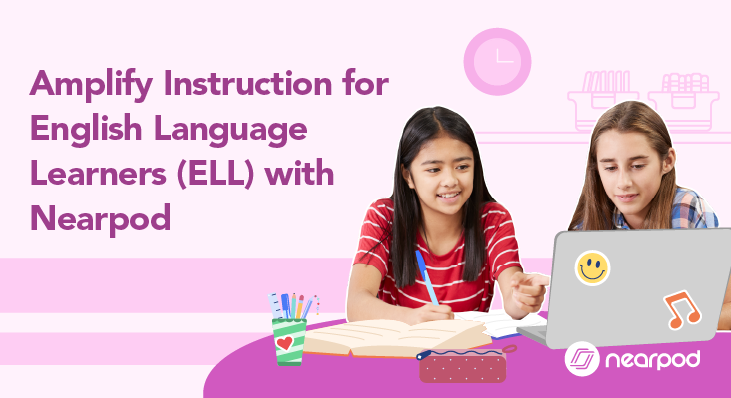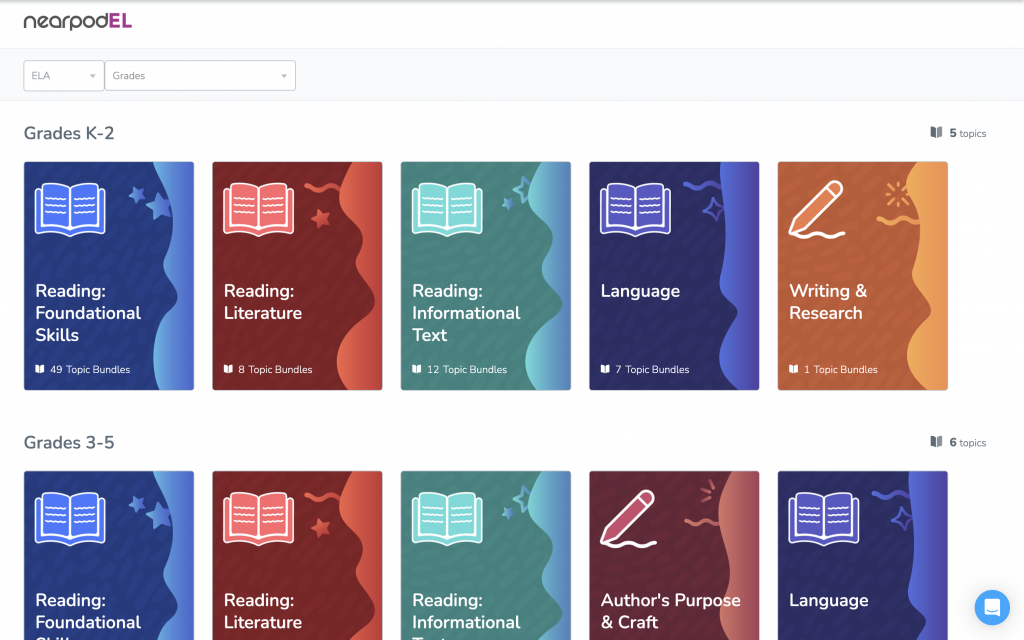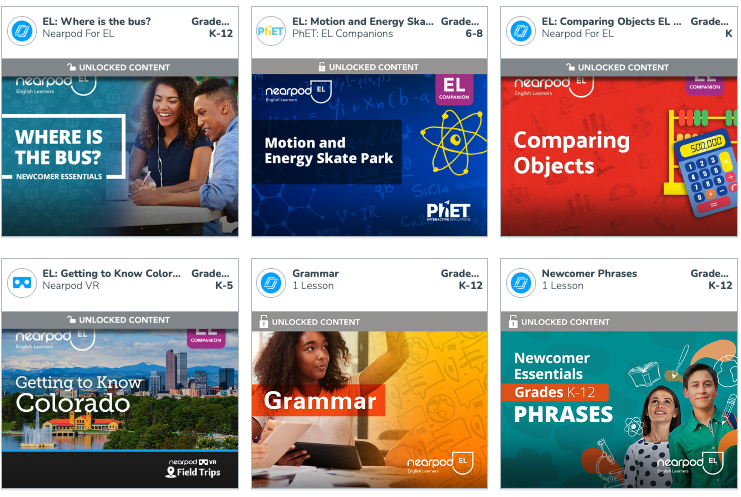
Amplify instruction for English language learners with Nearpod EL
Instruction that nurtures the academic growth of English language learners (ELL) students is crucial now more than ever. With ready-to-teach, interactive, standards-aligned lessons, designed to enrich the learning experience for ELLs, Nearpod’s EL Program is revolutionizing the way we approach ELL instruction. Join us as we explore the research-based approach to ELL instruction and how to differentiate learning with immersive, relevant, and scaffolded instruction with Nearpod EL.
4 Ways to amplify instruction for English language learners using Nearpod EL
1. A research-based approach to ELL instruction
A report by WestEd (2014) found that teachers of English language learners (ELL) must design their instruction to “amplify rather than simplify” concepts to offer the academic rigor necessary for students’ learning (p. 11). In other words, teachers must augment their lessons to include multiple pathways to learning, particularly when it comes to providing plenty of verbal and nonverbal messages (11). This is challenging, especially for teachers who may teach a range of students.
Nearpod EL aligns with this model of amplification and supports teachers in its implementation. With Nearpod EL, ready-to-teach lessons provide an interactive, standards-aligned curriculum designed to engage and inspire ELLs across subject areas and grade levels. Nearpod lessons leverage digital activities and research-based formative assessments to seamlessly connect instruction and evaluation to meet the unique learning needs of ELL students. The lessons are designed to teach rigorous Math, English Language Arts, Science, and Social Studies content through scaffolded instruction and strategies to support language acquisition.
Nearpod became integral to Compton Unified School District’s (CUSD) efforts to support English Language Learners (ELLs). Nearpod’s adaptability enabled effective scaffolding of instruction, providing multiple points of entry and immediate feedback crucial for language development.
2. Interactive lessons with clear learning goals
Within the design of each Nearpod EL interactive lesson, ELL students are at the center of teaching and learning. As the WestEd report demonstrates, interactive lessons created for ELL students should begin with clearly defined learning goals and objectives. Nearpod EL lessons are guided by these constructs and use learning progressions and success criteria as indicators of comprehension. By promoting a continual process of instruction, assessment, and feedback, lessons allow teachers to design their own instruction by immediately identifying gaps between current levels of learning and expected levels of learning.
With clear direction on learning goals, the Nearpod EL ready-to-teach lessons harness the power of interactive technologies and multimedia-rich content to highlight academic knowledge and academic language. As the lessons offer editable content, teachers further customize lessons according to individual needs and goals. This purposeful process of planning and building interactive lessons, and learning for ELL students becomes an enriched experience with great opportunity for growth.
3. Facilitates learning through authentic engagement
A best practice in instruction with ELL students facilitates learning through authentic engagement with interactive content and meaningful peer interactions and collaboration. Lessons within the Nearpod EL library balance direct instruction with experiential learning and continual practice in speaking and listening. Within a context of subject-matter learning, Nearpod lessons build on background knowledge by incorporating reference images and familiar multimedia, explicit references to key vocabulary, and metacognition and reflection. Through the gradual release of responsibility, students are empowered to reach for levels of independence with activities following an I do, we do, you do scaffolding of skill building.
Nearpod’s On the Fly feature lets teachers respond to teachable moments during instruction and encourage ELL students voice and choice within the lesson. Open-ended tasks allow for multiple points of entry, a practice described by WestEd as effective in revealing ELL students’ learning by demonstrating their understanding through varying modes of expression, including writing, speaking, drawing, and reading. With a range of interactive activities (such as Polls, Fill-in-the-Blanks, Quizzes, Draw It’s) and interactive content (including Nearpod Virtual Reality (VR) Field Trips, Nearpod 3D, interactive video, and audio responses), students are supported in all forms of learning.
ELL students participating in Nearpod EL lessons are not only part of the instruction process, but they become creators of their own learning by assessing their personal understanding and determining their particular readiness based on feedback and support embedded within each of the lessons.
4. Access real-time data to help guide instruction
Within an instructional program for English language learners, constant interpretation of evidence of student progress is needed to inform instruction. Nearpod EL provides teachers with real-time feedback and reporting based on student interactions and responses. This continuous feedback offers the status of students’ current learning and provides direction for moving students toward identified learning goals. As the lessons are designed to minimize irrelevant language and unnecessary information, teachers can easily pinpoint and evaluate the intended learning targets. Based on feedback obtained in these embedded checks for understanding, systematic support in the forms of modeling, prompting, and repetition can scaffold ELL students and move them toward content understanding. For both teachers and students, learning progressions within Nearpod EL’s lessons allow for immediate feedback for in-the-moment adjustments to help anchor and monitor skills throughout the process of teaching and learning.
Formative assessment is essential when it comes to better ELL student learning in both academic content and the development of academic language. The Nearpod EL curriculum was developed with this in mind and provides an interactive and engaging long-term solution for instruction.
Bring Nearpod EL to your school or district
Following the understanding that desired changes must start with dedicated teacher support, Nearpod EL training targets ELL teachers and their unique instructional needs. Demonstrating best practices in the use of Nearpod lessons for teaching, teachers participating in the Nearpod PD discover ways to use Nearpod EL for whole group instruction, independent practice, and enhanced learning opportunities. With a focus on “amplification” of learning and empowering ELL students in the classroom, Nearpod EL advances culturally responsive instruction and brings agency to all students in all classrooms.
References
Alvarez, L., Ananda, S., Walqui, A., Sato, E., & Rabinowitz, S. (2014). Focusing formative assessment on the needs of English language learners. San Francisco: WestEd.

Nearpod’s award-winning platform is used by thousands of schools around the globe, transforming classroom engagement.




